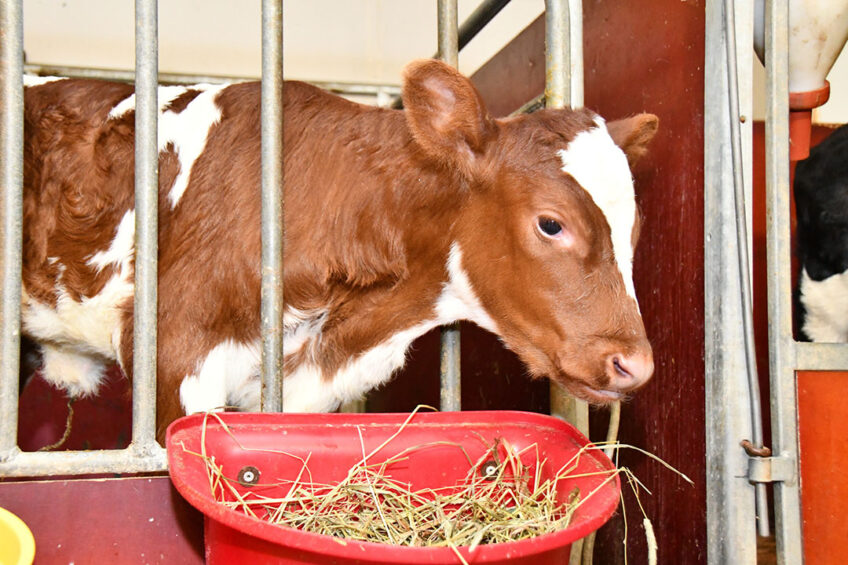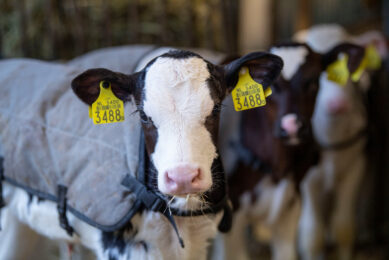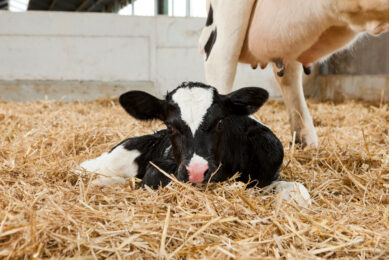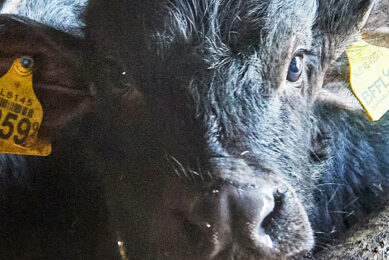Using dual-purpose breeds on dairy farms adds value

Choosing the correct genetics to use on dairy animals has always been a challenge, but that decision is becoming more difficult with fluctuating milk prices and consumer demands.
While milk prices are currently riding high, so, too, are the costs associated with producing milk, particularly feed, fertiliser and energy costs. With that in mind, dairy farmers should be considering every available solution that can increase the value of their produce, which also includes the bull calves from the herd.
In general, dairy farmers opt for around a 20-30% dairy heifer replacement rate for their cows each year, with some favouring sexed semen from their chosen bulls to achieve that.
Those farmers who do not use sexed semen run the risk of producing a dairy breed bull calf that is not worth any money to them and is an extra financial burden when considering rearing costs to sale age, or other disposal options.
Holstein Friesian bull calves have traditionally been sold on to veal producers across Europe or indeed to some beef fattening units, with varied success. In some countries these male calves have simply been slaughtered at birth.
As consumers are starting to have more say in the production methods of the food they eat, there has been a move in some areas to reduce bull calf numbers born in dairy herds.
Semen demand on dairy farms
Demand for semen on dairy farms varies across Europe, with some countries preferring to use more sexed semen than conventional semen from dairy breeds. The use of dual-purpose breeds and beef breeds in dairy herds is increasing every year as farmers aim to produce a more valuable calf to sell.

Ervin McKinstry is the Dynamic Markets European director for Genus ABS, which markets genetics to over 80 countries worldwide. He is responsible for Russia, Poland, Germany, Republic of Ireland and Northern Ireland, and says there has been a huge swing in semen buying trends, particularly in Northern Ireland, over recent years.
McKinstry says, “Five years ago in Northern Ireland we were selling just 10% sexed semen to dairy farmers, with 25% beef breeds to cross with the dairy breeds, normally British Blue and Aberdeen Angus, and the rest was conventional dairy breed semen.
“Today there has been a huge swing in trends and we are selling 45% sexed semen, 45% beef semen and just 10% conventional semen to dairy farmers there, probably one of the highest ratios within European dairy farming.
“Northern Ireland dairy farmers have been early adopters to using sexed genetics, combined with beef genetics to provide replacement heifers and a valuable cash crop of beef calves.
“We refer to this strategy as the Winning Game Plan, reducing the amount of pregnancies needed to Holstein and increasing beef calf sales, which reduces the farm’s carbon footprint and helps cash flow and profitability.
“Of the total amount of sexed genetics we sell, around 3% is HyVig (Norwegian Red) semen, 4-6% is British Friesian and the remainder is the Holstein Friesian breed.
“Trends are certainly changing and are different in each country. In Northern Ireland, alongside our traditional customers, we help to manage the fertility programme on 180 farms with 45,000 cows, around 15% of the national herd.
“The dairy breed bull calf is becoming a thing of the past in Northern Ireland as farmers opt to produce a higher value calf, whether it be a dairy breed female from sexed semen, or a beef breed, dual-purpose breed, male or female calf,” he adds.
Dual-purpose breeds
Over the years there has been a lot of research into the merits of using a dual purpose breed crossed with the conventional dairy breeds. Those merits include the production of a bull calf that has more value over a bull calf produced solely from dairy breeds such as the Holstein or Jersey breeds.
In general, cross-breeding has the potential for improved economic efficiency through the introduction of favourable genes from another breed that has been selected for the relevant traits, through avoidance of the negative effects of inbreeding and through capitalising on the expression heterosis as hybrid vigour.
Cross-breeding can be particularly important in the improvement of traits with low heritability, such as fertility and health. As expected, the cross-breeding in dairy herds results in the male cross-bred calves entering the beef industry.
These cross-bred calves bring in greater financial returns for the dairy farmer if they sell them as dropped calves. Also, they offer the beef farmer who buys them an animal that boosts the traits of both breeds, which can include faster growth rates, a better beef carcass and higher kill-out rates.
Popular Norwegian Red breed
One of the more popular dual purpose breeds that is being used widely across European dairy farms is the Norwegian Red breed, which is the main dairy breed in Norway.
Farmers have said this breed produces a calf that is equally suitable for milk production, if female, and for beef production. Male calf values when being sold at over 2 weeks of age are higher than those from the main dairy breeds, therefore giving the dairy farmer a good return.
Diego Galli is the EMEA regional sales manager with Geno SA, the organisation that breeds Norwegian Red cattle.
Galli explained why the breed is becoming very popular with dairy farmers outside Norway as a cross-breeding sire.
He states, “Norwegian Red is a dairy cattle breed but the beef traits have always been part of our breeding programme as well. Norwegian dairy farmers keep all bull calves for fattening, and traits like growth rate, slaughter weight, carcass muscling and fat grading are important and affect the farm’s economy.

“The value of beef production, including both males and females, represents a relevant part of the income for dairy farmers in Norway, and most of the cattle meat produced in the country comes from Norwegian Red animals.
“There are interesting studies done in Norway to collect data from Norwegian Red bulls for beef production and particularly one in 2009-10 where comparisons with other beef cattle breeds were made.
“Norwegian Red bull calves raised in beef farms performed well when compared to beef bull calves, including Angus for example.
“The bottom line is that by selecting Norwegian Red genetics, dairy farmers would benefit from a dairy breed that can also offer a high beef value,” he says.
Join 13,000+ subscribers
Subscribe to our newsletter to stay updated about all the need-to-know content in the dairy sector, two times a week.










